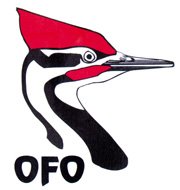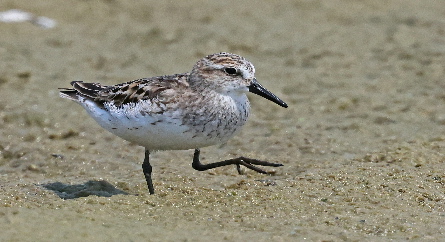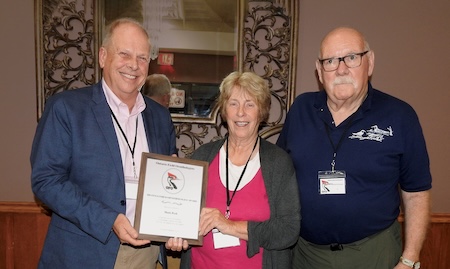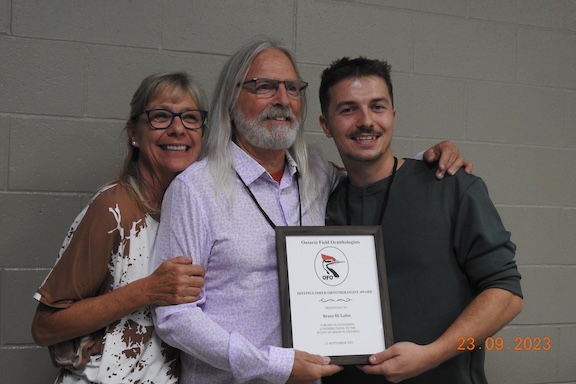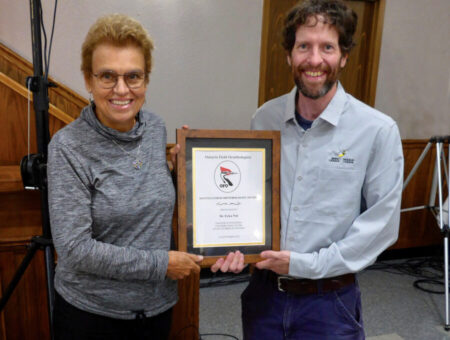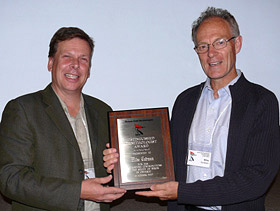On 28 September 2024 at the OFO Convention in Leamington, Ontario, Mark Kelday Peck received the Distinguished
Ornithologist Award of the Ontario Field Ornithologists (OFO) in recognition of his tremendous contributions to OFO
and the Ontario birding community as well as for research projects that have resulted in new ornithological
knowledge. We were delighted to nominate Mark for this award. During many gatherings over the years, Gerard often
spoke with Ron Pittaway, another OFO Distinguished Ornithologist, suggesting that it was time to nominate Mark for
the OFO award. However, people get busy and put things off, and so it didn’t happen until Jean, Gerard and John
finally motivated each other. We regret that Ron is not here to celebrate with us, but we know he is with us in
spirit to enjoy Mark’s special occasion.
When we three nominators called Mark to let him know that the editors of Ontario Birds and the OFO Board had
selected him as the 2024 Distinguished Ornithologist, he had to cut the call short as he was leaving to guide a
group of students — beginner birders in High Park. That struck us as totally in character and indicative of his
friendly and helpful nature. So many of us have benefited from Mark’s generosity of knowledge and of spirit, be it
as beginning birders or as fellow ornithologists.
Mark is well-known throughout Ontario and beyond for his professional collaboration, research, community-based
resource abilities, citizen science efforts and his volunteering. He is an outstanding birder, a collegial person
who shares his knowledge of birds and nest-finding and an exceptional field ornithologist.
Mark has been immersed in birds from an early age. He was born in Oakville, Ontario, into a family where birds and
birding reigned supreme. His father, George Peck, was a Research Associate at the Royal Ontario Museum and
coordinator of the Ontario Nest Records Scheme (ONRS). Family trips and vacations always involved birds and nature.
Photos of Mark as a toddler on a family vacation in Newfoundland show him with his father in a Northern Gannet
(Morus bassanus) colony, and in another photo, toddler Mark and his sister, Leslie, are looking intently at eggs in
an American Herring Gull (Larus smithsonianus) nest. In another photo with his brother, Cam, a turtle at Rondeau has
their delighted attention. At age 11, Mark recalled being on a two-week eastern Ontario field trip for the ONRS.
This set a pattern of father-son nest records trips through Mark’s teenage years. Mark now follows in his father’s
footsteps, as George was awarded the 2001 OFO Distinguished Ornithologist Award.
Royal Ontario Museum: 1983 to 2024
After graduating with a BSc. from the University of Western Ontario in London in 1981 and studying photography at
Sheridan College from 1982 to 1983, Mark began his remarkable career as Technician, Ornithology Collection at the
Royal Ontario Museum in Toronto. Here, he managed the largest bird research collection in Canada and one of the
largest and most complete in the world. He has provided researchers, artists, birders, nature clubs, schoolchildren
and many others access to birds like no other. Mark welcomed OFO Young Birders, the Feminist Bird Club, the Toronto
Ornithological Club and many other clubs and individuals to the ROM to view and appreciate its ornithological
treasures. He also reached out to communities in southern Ontario by visiting clubs, leading walks, giving
presentations and collecting dead birds under permit for the ROM. Birders and the other members of the public could
always reach him to answer their bird-related questions. The ROM website describes Mark as “completely bird crazy!”
What a great compliment!
Mark coordinated the long-running ONRS, which is now part of Project NestWatch, organized by Birds Canada and the
Cornell Lab of Ornithology, which also created eBird. Recognizing the importance of preserving data and having them
available to the public, Mark has ensured that historical ROM bird records have been entered into eBird. He is also
on an iNaturalist leadership committee.
Mark’s positive attitude has helped many develop their birding skills and a love of birds. Through the 1990s, the
ROM offered a birding course, Introduction to Birding, with Mark as a co-leader with Glenn Coady. Birders who
started birding with this course still attribute their appreciation of birds to Mark and Glenn. When he was Director
of the Environmental Visual Communications program with ROM and Fleming College, Mark welcomed students to the ROM
for this postgraduate certification course.
In addition to all Mark’s bird and ornithology related ROM assignments, he managed the Schad Gallery of Biodiversity
from 2019 to 2023. Other responsibilities included working on several fascinating displays and galleries: The
Patrick and Barbara Keenan Family Gallery of Hands-on Biodiversity; Tall Grass Prairie; and Gallery of Birds. Mark
was the Curatorial Consultant for several exhibitions, including Elegy: Deborah Samuels; Audubon’s Wilderness
Palette: The Birds of Canada; Great Whales: Up Close and Personal; and The Nature of Birds: A Photo Essay.
Sharing a speaking engagement with Mark, as John Carley once did at the Toronto Central Reference Library, was to
have more fun than the audience. The presentation topic combined Toronto birding with the Library’s Audubon
exhibit and featured the ROM’s unique shakily mounted glass-encased Great Auk (Pinguinus impennis) specimen as the
centerpiece, as this specimen was the model that Audubon used for his folio. The bird dominated the discussion, as
Mark explained its ornithological importance and its extinction. All the while, any movement caused the auk to
teeter in its case, upstaging both speakers.
As an accomplished photographer, Mark’s talent has been invaluable in his role as curator and judge of the
prestigious international Wildlife Photographer of the Year annual exhibit at the Royal Ontario Museum.
Mark says of his tenure at the ROM, “I had the best job in Ontario for birds, and I wanted to give that back to the
community.” Many birders and members of the public have benefited from this generosity of spirit.
Ornithological Field Work
Mark has worked alongside several ROM curators on a wide variety of Canadian and international ornithological and
conservation projects. Research on shorebirds, gulls, vireos, kiwis and other species necessitated travel to
Australia, New Zealand, Texas, Hudson Bay, James Bay, Thunder Bay, Gogama, MacGregor Point, Manitoulin Island,
Cambridge Bay, Akimiski Island, Mingan, South Africa, Tunisia, Morocco, Vietnam and many more places across the
globe.
Mark’s involvement with Red Knot (Calidris canutus) research began in 1995, when he participated with ROM Curator of
Ornithology, Dr. Alan Baker, in a study to sample Red Knots in Argentina. Since then, Mark has been a member of an
international research team conserving the endangered rufa Red Knot subspecies and other shorebirds. This research
has taken him banding and sampling shorebirds in Delaware Bay in the United States (annually since 1997), expanding
to Argentina, Chile, Brazil, Florida, Virginia and Southampton Island in Nunavut. Larry Niles and Mark’s many
research colleagues and friends in New Jersey welcome him every spring to survey and band Red Knots and other
northbound shorebirds that are feasting and fattening up on Horseshoe Crab eggs prior to their migration to the
Canadian Arctic.
Mark’s interest in shorebird conservation was known to Ken Abraham, Research Scientist with the Ontario Ministry of
Natural Resources (OMNR), who suggested a three-week study in James Bay to assess Red Knot and other
species-at-risk. As a result, in 2009, Mark and a number of dedicated volunteers undertook the first Red Knot survey
along the coast of James Bay. The following year, Christian Friis, Canadian Wildlife Service (CWS), joined the
program and the James Bay Shorebird Survey was born. This important annual monitoring and research project, a
collaboration between CWS, OMNR and the ROM, brought world attention to the hemispheric importance of the west
coast of James Bay to migrating southbound shorebirds. Globally significant numbers of several species such as rufa
Red Knot, Hudsonian Godwit (Limosa haemastica), Semipalmated Sandpiper (Calidris pusilla), White-rumped Sandpiper
(Calidris fuscicollis) and Dunlin (Calidris alpina) depend on James Bay which recent research has established as the
most important area in Ontario for migrating southbound juvenile and adult shorebirds.
Those of us who have had the privilege of surveying and banding shorebirds with Mark can attest to his amazing
physical fitness. Daily walking and surveying 15-20 km of the James Bay coast carrying a scope and gear in all
weather conditions through boot-sucking mud, over hummocks, through marshes and tidal pools while dodging black
bears is routine for Mark. Then, after a full day of surveying, Mark had our crew up at night banding and putting
Motus trackers on shorebirds! Even with intense work, there was tremendous camaraderie around camp. Mark believes
that eating well is important for morale, so he always brought his camp oven for baking bread, scones and birthday
cakes, while his collection of herbs and spices turned every meal into a gourmet treat.
Toronto Ornithological Club (TOC)
Every member of Mark’s home club knows him and appreciates his work as Programs Councillor, organizing interesting
and informative speakers for every meeting from 2009 to the current year. Mark himself is a popular speaker on a
variety of topics: loons, the Ontario Breeding Bird Atlas, ethical photography, Red Knots, the Far North, James Bay
shorebirds, and much more. He is a sector leader for the annual Christmas Bird Count, always welcoming new birders
on his route. Mark leads field trips to the ROM for new members, a nest search educational walk in local parks and
ravines and many other birding events.
Mark is the TOC and ROM representative at BIRDSafe UofT, an organization working to make the university’s huge glass
windows safer for birds. In October 2023, he received recognition from BIRDSafe UofT for all he does to protect
birds and educate the public.
Each year in May, the Toronto Bird Celebration is a popular birding festival with over 35 inclusive programs, walks
and events for the public. Birds Canada coordinates the organization with TOC, Toronto Parks, ROM and many partners.
Mark is a valued committee member and event leader.
Royal Ontario Museum liaison to the Fatal Light Awareness Program (FLAP) Canada: 2009 to present
Mark became an advocate and supporter of FLAP Canada. He believed in FLAP’s goal to “envision a 24-hour
collision-free built environment for migratory birds” and became its “voice” at the Royal Ontario Museum. Mark was
instrumental in bringing FLAP’s annual Birds Layout to the ROM, frequently coordinating it with Earth Day events at
the museum. As a result of the accrued publicity FLAP’s profileand mission benefited greatly! Additionally, Mark
became the go-to person for the identification of dead birds and for bringing those dead specimens (salvaged by FLAP
volunteers on their daily patrols) into the ROM for the ROM collection and/or for research purposes. In addition to
hosting workshops in 2012 and 2013 for FLAP volunteers, Mark hosted an evening lecture, “Birds & Buildings Changing
Toronto’s Skyline,” in April 2017, through the ROM auspices, with three speakers on bird-friendly issues. Furthering
his connection with FLAP, Mark appeared with FLAP personnel in the 2015 movie The Messenger, which highlighted the
dangers and issues affecting bird populations.
Ontario Field Ornithologists: 2000 to the present
Mark is well-respected amongst OFO members as a trip leader, workshop presenter, resource person and author of
articles in OFO News and Ontario Birds. For many years, he challenged participants with his fun gull quiz at the
very popular workshop on the December OFO Gull Weekend. He also organized and hosted the annual “look behind the
scenes” at the Royal Ontario Museum for young birders.
Mark has a long association with OFO through the ROM and the Ontario Bird Records Committee. In 2000, he succeeded
Dr. Ross James as ROM liaison to the OBRC, hosting the OBRC annual meetings at the ROM and acting as a resource to
the Committee. This is a non-voting position, though Mark was a voting member for a three-year term from 2006 to
2009. At the OFO Convention in 2017, Mark was awarded an OFO Certificate of Appreciation “for his years in assisting
the Nest Records Scheme, as ROM liaison on the OBRC, and for providing expert opinion on records reviewed by OBRC
over the past decade.”
Because of Mark’s presence in the birding community, he acquired for the ROM some very rare birds that died in
Ontario. An example was Hannah the Rufous Hummingbird (Selasphorus rufus), which frequented the feeders of Art and
Janice Haines in Niagara Falls in 2004. Many birders visited and were saddened when the hummingbird died of cold
overnight.
Mark reached out to the homeowners and the hummingbird is now preserved as a specimen at the ROM. At the Convention
in 2005 he presented an OFO Certificate of Appreciation to Art and Janice. Other recent acquisitions due to Mark’s
many contacts are the Limpkin (Aramus guarauna) from Wheatley Provincial Park in January 2024, Western Tanager
(Piranga ludoviciana) from Ottawa in March 2024, and the female Barrow’s Goldeneye (Bucephala islandica) from
Hillman Marsh in April 2024. All are specimens at the ROM.
Mark continues as Ornithological Consultant to Ontario Birds from 2002 to the present. He is now a member of the OFO
Board of Directors.
Ontario Breeding Bird Atlas
Mark has volunteered for all three Ontario Breeding Bird Atlasses. During the first Ontario Breeding Atlas-1
(1981-1985) he was an atlasser, already showing an uncanny ability to find nests and document breeding. In the
second Ontario Breeding Atlas-2 (2001-2005), Mark was on the Technical/Bird Change Committee and Significant Species
Committee. He was an atlasser, species account reviewer and species account author. Mark loves northern Ontario and
the Hudson Bay Lowlands. He and Gerard were on teams that atlassed in the remote far northern parts of Ontario where
they camped, canoed and appreciated what a special project the Atlas is. Gerard commented: “Few people have eaten as
well as our teams in the middle of nowhere as we did since Mark did the menu planning and much of the cooking and
baking.”
During these second Atlas trips their teams documented first Ontario nesting for three species: Pine Grosbeak
(Pinicola enucleator) and Bohemian Waxwing (Bombycilla garrulus) in the north and Black-necked Stilt (Himantopus
mexicanus) in southern Ontario. Additionally, they submitted nesting documentation for several species that had
fewer than 10 prior Ontario records. Gerard also noted: “Mark’s nest finding ability is, in my opinion, second to
none. Many of us see a tree or shrub and nothing else. Mark sees that there is a nesting bird there and we are all
shaking our heads wondering how we missed it.”
In the Ontario Breeding Bird Atlas-3 (2021-2025), Mark is the Toronto area Regional Coordinator and is on the
Significant Species Committee and Northern Committee. He is a volunteer atlasser in southern Ontario and continues
to participate in remote atlas surveys in the Hudson Bay Lowlands and elsewhere in the province.
A prolific photographer and contributor
Mark made significant contributions to many books and field guides. For the 2001-2005 Atlas book publication, Mark
authored or co-authored 14 species accounts and provided 54 photos of their eggs, nests, young and habitat. He also
wrote many species accounts in The Birds of Nunavut, as well as providing photos. He has authored and co-authored
many articles in peer-reviewed scientific and popular publications, including Ontario Birds and OFO News. An example
of Mark’s support for Ontario Birds was during the huge 2004-2005 irruption of Great Gray Owls into southern
Ontario. That winter hundreds of Great Gray Owls (Strix nebulosa) died in collisions with automobiles and from other
causes, and many were sent to the ROM. Mark and his associate compiled a 16-page article with photos for Ontario
Birds, which was published in the December 2005 issue. An historic irruption and mortality event became an
authoritative article.
Marks photographs have been used in journals, websites and the original song app, Dendroica. His photographs were
used extensively in the most recent Peterson Field Guide to North American Bird Nests. He also gives presentations
about ethical bird photography. One of Mark’s goals is to photograph the nest and eggs of all the birds of Ontario.
Closing thoughts
The Moose Cree First Nation were partners in the James Bay Shorebird Project and members joined us doing surveys
along the coast. In 2014, two brothers, Darrell and Jeff Issac, came to Little Piskwamish camp. They were fantastic
crew members and we learned so much from them. On our last day at camp, Darrell spoke for Jeff and himself. He
thanked our crew for our warm hospitality and said our passionate study of the shorebirds was an inspiration to both
of them. He then focused on Mark: “…and especially you Mark, on taking the time to share your knowledge and teach us
the several types of shorebirds living off the James Bay coast. You inspired both of us in so many ways to continue
our own bird study. With your knowledge and teachings we learned to recognize not just shorebirds, but different
species of birds living on our homelands, such as Greater and Lesser Yellowlegs. The challenge was rewarding and
appreciated so again we thank you so very much. Megwetch.”
We all echo Darrell’s words. Thank you Mark for sharing your passion and knowledge of birds and their conservation.
Thank you for inspiring us and for having a presence in the birding community, bringing the science to us and taking
us to the science. Thank you for your tireless research and efforts for bird conservation.
Jean Iron, Gerard Binsfeld and John Carley
